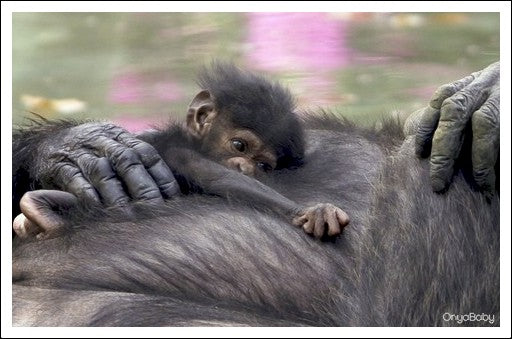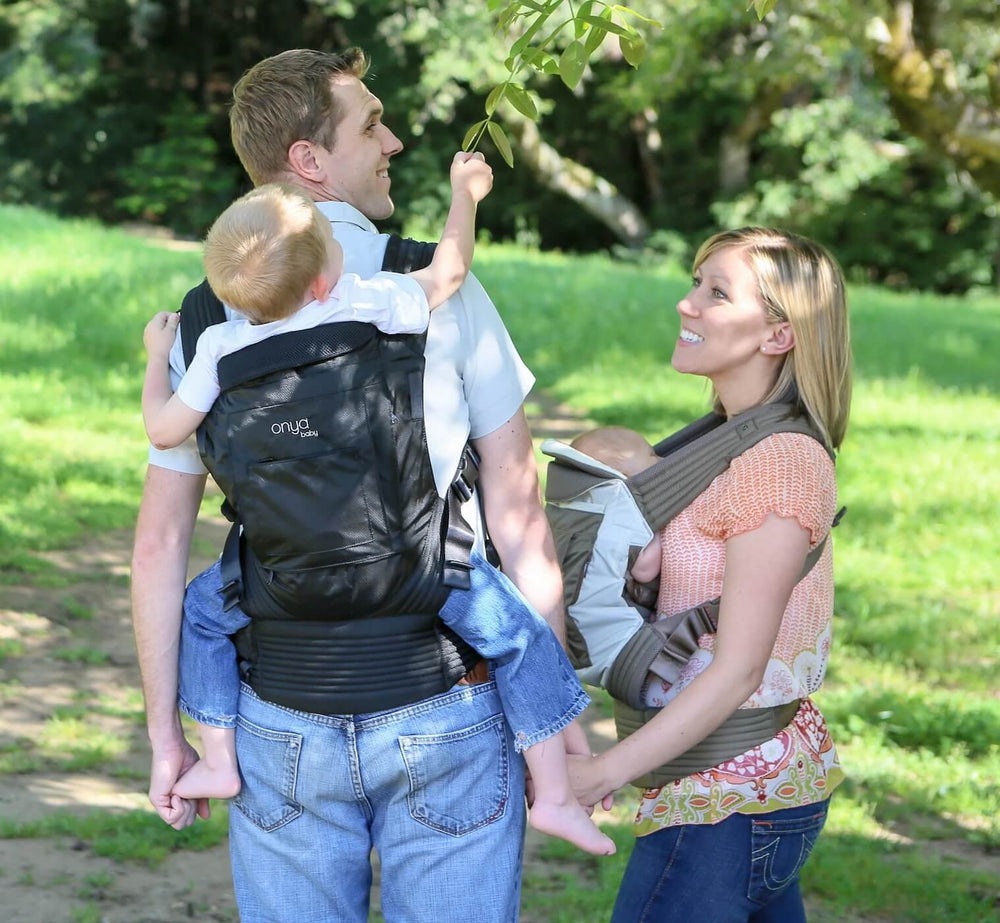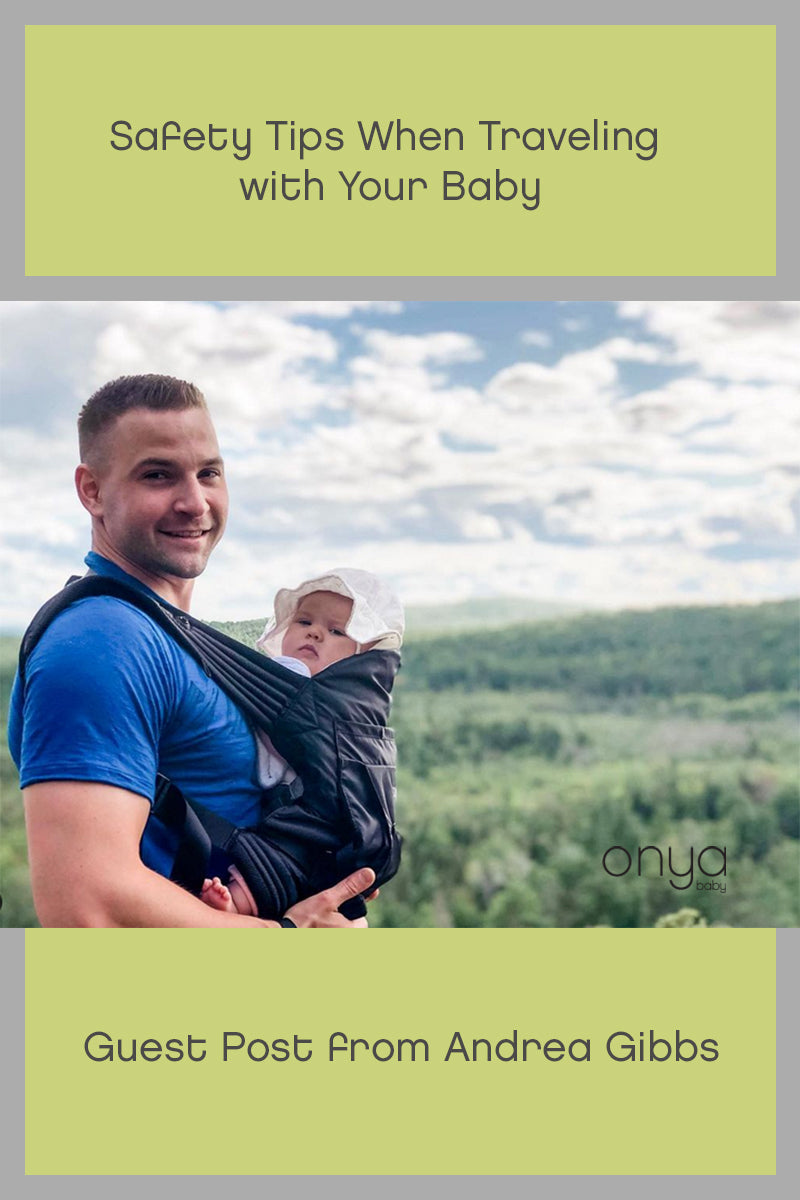Evolution, Parenting and Babywearing…

Picture it: you’re in your cave, snuggled in the warm furs and leaves of your bedding with your family sleeping around you. Your baby, tucked in the nook of your arm, nurses at your breast. You sleep together, keeping each other warm during the cold winters, and you know where each child is during the night. But now, as the sun begins its morning ascent, you must arise to begin the work of the day. There is food to gather, prepare and store. The cave must be cleaned to keep scavenger animals away. You take your square of hide and your strips of leather thong and tie your baby to your back to begin your day. Your baby is now safe with you and you’re ready to roll. Time to get moving…
If we look at babywearing, which is defined as the practice of wearing or carrying a baby in a sling or in another form of carrier (1), from an evolutionary perspective, it simply makes sense. As a practice, it crosses cultures and spans millennia. In its most functional form, babywearing is simply the most practical way for a caregiver to transport a baby, particularly over uneven terrain. Long ago, during the dawn of our days as hunter-gatherers, mothers needed a way to keep their babies safe and close while they completed the tasks of daily survival. A baby left alone is a baby in potential danger.
A baby left alone is helpless; completely dependent upon his caregivers to care for and protect him. Human infants aren’t the only primate babies to need close care-giving, but they are the least developed at birth, physically and neurologically. Chimpanzees, our closest primate cousins, can hold onto their mother shortly after birth. This not only allows the primate mother to go in search of food and shelter, but it also allows the mother to have her hands free to move about, gather food and climb while keeping her baby close and safe. In contrast, for many months following birth, human babies aren’t able to grasp with the strength needed to hold onto their mothers. No baby is safe when left alone at a very young age, no matter the species. Carrying her baby in a sling or baby carrier is the most sensible solution for the human mother, whose baby has no other way to remain attached to her while she moves about as needed. This was true in the dawn of humanity and continues to remain true today.

Humans and primates alike rely on caregivers to care for their young, but human infants are especially helpless. Not only are human infants physically dependent upon their caregivers for survival, but their brains are also comparatively underdeveloped. “By one estimation a human fetus would have to undergo a gestation period of 18 to 21 months instead of the usual nine to be born at a neurological and cognitive development stage comparable to that of a chimpanzee newborn.” (2) In other words, “children have a very long developmental period, relative to other comparably sized mammals and primates, and are highly dependent on adult caregiving.” (3) In many cultures, “mothers are the principal caregivers, providing extensive body contact day and night and prolonged breast-feeding. When not carried, the baby of hunter-gatherers has complete freedom of movement. Care is consistently affectionate, with immediate nurturant response to crying. Nonetheless, in most groups, children achieve early independence and by 2 to 4 years spend more than half the time away from the mother.” (4) During the time of hunter-gatherer groups, early independence was vital to the group’s survival. Children would, as soon as they were capable, would be expected to assist in the duties of daily survival. The child’s familiarity with daily activities, which would have come from being carried on the mother’s front and/or back, would serve the child, the mother and the group as a whole, because the time to teach the child his duties would be lessened than if he had been kept separate from daily life.

Another important way that babywearing makes evolutionary sense is that it helps calm babies. Babies who are carried often are calmer and cry less than babies who are not. (5) In the dawn of humanity when humans lived in much closer proximity to predator animals then we do now, the cry of a baby had the potential to attract hungry predators. A baby is instinctively tuned to cry when left alone for this evolutionary reason. We are born with a deep-seated biological and evolutionary need to be held as infants because it is the very safest place for a newborn baby to be. When the baby is on the mother, she’s also closest to the mother’s breast, a constant source of nourishment and comfort. In addition, the close contact also serves to regulate the baby’s body temperature and aides in “reduced stress, enhancement of mother-infant bonding, and positive effects on the family environment and the infant’s cognitive development.”(6)
From an evolutionary parenting perspective, the benefits of the placement of the baby on the mother makes deep biological sense. It’s deeply ingrained in our evolutionary practices as humans as a natural response to having babies and the need to keep them close. This is why, for so many babies and so many mothers (and, increasingly, fathers) it just feels right.

If you wear your baby, you’re in good company; connected through the ages by our shared history as mothers, as humans. Welcome to the club.
Happy babywearing!
References:
1. Babywearing – Wikipedia. Link
2. Wong, Kate. “Why Humans Give Birth the Helpless Babies.” Observations, Scientific American Blog Network, August 28, 2012. Link
3. Bogin, B. “Evolutionary hypotheses for human childhood.” Yearbook of Physical Anthropology, 40, 63–89. 1997
4. M.D. Lozoff, Betsy, M.D., Brittenham, Gary. “Infant Care: Cache or Carry.” The Journal of Pediatrics, Vol. 95, Issue 3, 478-483. September 1979.
5. Hunziker, Urs A., Barr, Ronald G. “Increased Carrying Reduces Infant Crying: A Randomized Controlled Trial,” Pediatrics, Vol. 77, No. 5. 641-648. May 1 1986.
6. Charpak, N., Ruiz, J.G., Zupan, J. et al. “Kangaroo Mother Care: 25 Years After,” Acta Paediatrics, Vol. 94, No. 5. 514-22. May 2005.








